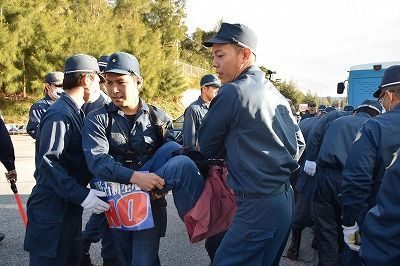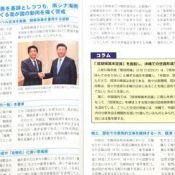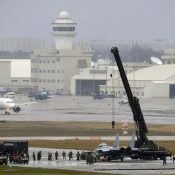Top News
February 2, 2017 Ryukyu Shimpo
In light of a U.S. military helicopter making an emergency landing on an agricultural road in Uruma City, Yonashiro, Ikeijima, the Okinawa Defense Bureau (ODB) offered reparations to the Ikei neighborhood community association. On the first of the month, the neighborhood association denied the offer and made a call to protest. Head of the association Masanori Tamashiro said to the press that accepting compensation means accepting continued U.S. base presence. He went on to say residents want to object, and push the U.S. military to no longer make flights in the sky above each island. The heads of Henza, Miyagi, and Hamahiga Islands’ neighborhood community associations coordinated with Ikeijima in the call to protest, requesting suspension of flights over these four islands.
In response, the ODB asserted that the US-Japan Status of Forces Agreement Article 18 sets forth the ways in which reparations are handled in regards to local governments and cultivators of agricultural land in the vicinity of landing sites.
Following the call to protest, Tamashiro criticized the military aircraft’s emergency landing and quick takeoff over a residential area afterward. He said: “It isn’t an issue of reparations. If the U.S. military bases weren’t here, such incidents would not occur.”
(English translation by T&CT and Erin Jones)
Go to Japanese
政治

February 2, 2016 Ryukyu Shimpo
Sakae Toiyama reports from Washington D.C.
On the afternoon of January 31, Governor Takeshi Onaga began his action in Washington D.C. to convey Okinawa’s opposition to the construction of a new base as part of the relocation of U.S. Marine Corps Air Station Futenma to Henoko, Nago, and to call for the plan to be changed. On January 31, Governor Onaga met with Congress members and their staffers, and with researchers specializing in Japan at the Congressional Research Service, which regularly publishes reports that U.S. Congress members use as reference when making policy decisions.
At his meeting with the researchers, Governor Onaga emphasized that 70% to 80% of Okinawans oppose the Henoko relocation, and that amidst such opposition, it would take 15 to 20 years for the relocation to be completed. He also said that he plans to act objectively using his authority as governor to respond to any design changes related to the new base construction, conveying the expectation that although Japan’s Supreme Court ruled against Okinawa in the lawsuit over the cancellation of the Henoko land reclamation permit, the relocation work will not progress smoothly.
After the meeting, Governor Onaga told reporters, “In the United States, there is a misunderstanding about the Supreme Court’s ruling. People have expressed the understanding that the ruling indicates that [the relocation problem] is resolved. There is an overwhelming gap between the information propagated by the Japanese government and that which I have conveyed. I spoke to them on that premise.”
Starting on February 1, Governor Onaga will meet with members of the Senate and the House of Representatives who serve on their respective Armed Services Committees and Foreign Affairs Committees.
(English translation by T&CT and Sandi Aritza)
Go to Japanese

January 27, 2016 Ryukyu Shimpo Digital Edition
(Henoko issue reporting team) To facilitate the construction of a new base in Henoko, Nago in conjunction with the relocation of U.S. Marine Corps Air Station Futenma, on January 27, the Okinawa Defense Bureau brought floats with support pillars attached into the sea and continued work on an above-sea fence around the planned construction area. The Bureau appears to be almost finished with the work of surrounding the temporary restricted zone with the above-sea fence and floats.
Around thirty sit-in protesters gathered to protest at the U.S. Camp Schwab gate used by construction
vehicles. The riot police began to remove protesters from the scene at 8:46 a.m., after which three trucks with cranes attached entered the base. Thereafter, the protesters relocated to a spot from which they could see the ocean and called out, “Return Oura Bay to us!” and “Never succumb to pressure!”

Riot police remove protesters at 8:47 a.m. on January 27 in front of the gate to U.S. Camp Schwab in Henoko, Nago
Protesters opposed to the construction also used protest boats and kayaks to enter the ocean zone. Approximately ten Coast Guard boats were patrolling the area to ensure that the protesters would have no effect on the construction work.
(English translation by T&CT and Sandi Aritza)
Go to Japanese

January 18, 2017 Ryukyu Shimpo
Japan’s Public Security Intelligence Agency claimed in its latest report that China was moving to deepen its ties with Ryukyu (Okinawa) independence groups through academic exchanges, and that it could be a strategy to divide Japan by promoting favorable public opinion of China.
The intelligence agency noted in the report, Retrospect and Outlook on Internal and External Situations in 2017, that China had called on the international community to caution against Japan’s drift to the right.
According to the report, China approached Ryukyu independence groups, which demand the withdrawal of all U.S. bases from Okinawa, where the U.S. bases in Japan are concentrated. The intelligence agency suggested that China was moving to promote favorable public opinion of the communist nation, alleging that the inclusion of the Ryukyus within Japan remains legally unconfirmed.
In its report, the intelligence agency also referred to an opinion column published in August in the Global Times, a subsidiary of the People’s Daily. The opinion column stated that China should use the old name Ryukyu to refer to the islands because calling them Okinawa was tantamount to accepting Japanese sovereignty over them.
The Second Ryukyu Okinawa Frontier Issue International Academic Conference was held by historians from Okinawa and China at Beijing University in May 2016.
“The Ryukyu independence groups” described in the report seem to refer to the historians who took part in the conference from Okinawa.
The intelligence agency stated: “The Chinese side, including think tanks, facilitates academic exchanges with Japanese groups, which advocate for Okinawa’s independence movement, and they have visited Okinawa.”
The intelligence agency refused to answer questions about which think tanks in China were involved, when and how many times members of the think tanks visited Okinawa.
Regarding the reports, the intelligence agency said, “They are not the official statements from the Chinese government. We did not refer to the Chinese government in any sentences.”
The intelligence agency, which is administered by the Ministry of Justice, analyzes information on domestic and foreign terrorist organizations and the situations in various countries including China. The report will be published on the agency’s website for the remainder of Fiscal 2016, which ends March 31.
Intellectual criticizes “low-level thinking.”
Morikiyo Matayoshi, affiliate professor at Okinawa University, who coordinated The Second Ryukyu Okinawa Frontier Issue International Academic Conference, said, “It is a matter for Okinawan people to decide whether to become an independent country or not. This isn’t a matter for China to decide.” He added, “None of the members of the conference has heard from the intelligence agency. It is irresponsible for an organization to announce such a claim without carrying out enough research.”
Teruo Hiyane, professor emeritus of the University of the Ryukyus, said, “The purpose of the conference was to retrace the footsteps of the Ryukyuan people around Beijing. At the conference, we discussed the recent contemporary history of Okinawa and the military base issue,” “I doubt that they have read what was discussed at the conference. Their approach reflects too much low-level thinking,” He criticized the intelligence agency for committing hate speech against Okinawa.
Yasukatsu Matsushima, professor at Ryukoku University and co-leader of the Association of Comprehensive Studies for Independence of the Lew Chewans (ACSILs) , said, “There is no concept among Chinese researchers that China will invade if Ryukyu become an independent country.” He denied the idea that the Ryukyu independence movement will do China good.
Hiroyoshi Sunagawa, professor at Rikkyo University and researcher into the relationship between power and media, indicated that the content was inappropriate. He further said, “Together with news media in Okinawa we have to refute it based on the facts.”
(English translation by T&CT)
Go to Japanese

January 31, 2017 Ryukyu Shimpo
The detention of chairman of the Okinawa Peace Movement Center Hiroji Yamashiro, who took on a central role in the movements opposing Henoko base construction and Takae helipad construction, has continued for more than 100 days. He was arrested and indicted on suspicion of obstructing official business by force. On January 30 an emergency gathering to call for his prompt release met in front of Naha District Courthouse.
At this gathering Satoko Norimatsu, an editor of The Asia-Pacific Journal: Japan Focus, read aloud Amnesty International’s English urgent action document calling for the prompt release of Yamashiro, which was made public on January 26. She called for an immediate end to Yamashiro’s unjust detention, as Japan has ratified the International Covenant on Civil and Political Rights (ICCPR). After the reading, Norimatsu and co-representative of the emergency gathering Isamu Nakasone submitted Amnesty International’s urgent action document to Naha District Court.
(English translation by T&CT and Erin Jones)
Go to Japanese
January 28, 2017 Ryukyu Shimpo
Sakae Toiyama reporting from Washington D.C.
The international human rights organization Amnesty International began an international campaign calling for the immediate release of Hiroji Yamashiro, director of the Okinawa Peace Movement Center on January 26. Yamashiro was arrested, indicted, and has been detained for an extended period of time for his part in the protests opposing the new base construction in Henoko and the helipad construction in the Northern Training Area. Advocates are writing letters to Prime Minister Shinzo Abe and Attorney General Katsuyuki Nishikawa with demands that include the immediate release of Yamashiro, access to medical treatment, and visitation rights for his family.
The organization is also looking into recognizing Yamashiro as a “prisoner of conscience,” as he was arrested for his political beliefs. This extraordinary situation has the international community calling into question Japan’s awareness of human rights.
Amnesty International has indicated that the health of Yamashiro, who was undergoing treatment for malignant lymphoma, is worsening. They have also see the possibility of the courts extending his detention to February 20, and the lack of family visitation rights, as problems.
They have also presented calls from legal researchers throughout Japan claiming that Yamashiro’s imprisonment is unjust, and that he should be released quickly. There were demands that international human rights laws be adhered to, and the detention be investigated to see if it meets international human rights conventions, which state that imprisonment needs to be “legitimate, necessary, and proportional.” Furthermore, as the Japanese government continues U.S. military base construction despite strong opposition, the arrest of Yamashiro is being seen as an attempt to quash protests.
Amnesty International is requesting advocates write letters to Prime Minister Abe and Attorney General Nishikawa, as well as post on their Facebook pages and contact them through twitter to demand three emergency actions be taken: (1) immediately release Yamashiro unless they can prove that it would not be suitable to release him until the trial, (2) quickly offer him appropriate medical care and secure visitation rights for his family, and (3) respect the rights of freedom of speech and peaceful assembly, and the human rights of prisoners.
Amnesty International’s “prisoners of conscience” have included people such as Myanmar’s democratization leader Aung San Suu Kyi.
(Translated By T&CT and Sam Grieb)
Go to Japanese
January 31, 2017 Ryukyu Shimpo
Governor Takeshi Onaga has departed for his third trip to the United States since taking office. He will visit Congress members and think tanks that have influence on the new Trump administration and call for abandonment of the plan to build a new base in conjunction with the relocation of U.S. Marine Corps Air Station Futenma to Henoko, Nago.
Compared to his previous two trips, Governor Onaga is now facing a headwind. Okinawa lost a lawsuit brought against it by the national government and was forced to reverse its action to prevent the base construction. The Abe administration has resumed construction at sea and is increasing pressure on Okinawa.
In addition, Governor Onaga’s right-hand man in dealing with the base issues, Vice Governor Mitsuo Ageda, recently resigned amid suspicions that he used his position to intervene in the hiring of public schoolteachers, dealing a blow to the prefectural administration. The Onaga administration is in a state of confusion and urgently needs to get back on its feet.
In order to resolve this challenging situation, the governor and All-Okinawa Coalition members who are accompanying him to the United States must take strategic action and not be tied down by conventional conceptions.
More than 70% of Okinawans continue to oppose the construction of a new base, which will harm the natural environment and people’s lives, making it absurd to follow through with the plan. The recent Osprey crash also sent shockwaves throughout Okinawa. The governor should explain these things clearly. U.S. bases in Okinawa are operated under flagrant double standards, as seen from the implementation of drills that involve suspending objects below aircraft directly over residential areas, which would be unthinkable in the United States or Europe. This threatens the universal value of human rights, and the governor must convey this fact as well.
Trump’s national security team features former military officers, specifically a former Marines, in positions of power. As Secretary of Defense, Trump appointed former Marine Corps General James Mattis, who has been nicknamed “mad dog”, and as Secretary of Homeland Security, he appointed former Marine Corps General John Kelly. On the National Security Council, the senior director for Asia is Matthew Pottinger, a former Marine.
With former Marines in positions of political power, the Marines will have strong influence on the government and Congress. We cannot deny the possibility that they will view the Henoko base as a vested interest and refuse to compromise.
It is thought that the Trump administration will follow in the footsteps of the Obama administration’s Asia-focused policy. However, it has yet to be seen how the new administration will handle specific issues such as the Henoko relocation or a possible request for an increase in Japan’s financial burden for the U.S. base presence.
Meanwhile, in Congress, Senator John McCain (Republican), chair of the Senate Armed Services Committee, appears ready to seriously consider steps toward closing and reorganizing U.S. bases in the United States and abroad, and this could impact U.S. bases in Okinawa as well.
We don’t know that sort of security policy will be advanced by Trump, with his “America first” policy of pursuing national interests. Okinawa must be prepared for whatever happens, while simultaneously rebuilding a strategy of our own.
Building a new base will increase resistance from Okinawans and will likely hinder stable operation of U.S. bases in Okinawa in the long term. It is as important as ever for the governor to continue making overtures to the United States.
(English translation by T&CT and Sandi Aritza)
Go to Japanese

January 27, 2017 Ryukyu Shimpo
With tourists from Thailand expected to increase due to new flights between Bangkok and Naha in February, the Okinawa Convention and Visitors Bureau (OCVB) is carrying out projects to support the expanding tourism market.
In addition to making services available in Thai language at the Multilingual Contact Center, the OCVB will also distribute 30,000 Thai-language guidebooks, which will provide tourism-related information on Okinawa such as how to use the public bus system.
According to the OCVB, the majority of Thai tourists were previously tour groups coming through Hong Kong and Taipei. However the new direct flights by low cost carrier Peach Aviation are expected to increase the number of individual tourists.
The number of Thai tourists to Okinawa has been increasing since the government relaxed visa requirements for visitors from Thailand in July 2013. The number of Thai visitors between January and December in 2016 was 7,200, which was an increase of 24.1 percent compared to its previous year. The highest number of Thai visitors was in 2013 and 2016, according to data made available by the prefecture since 2012.
To promote trips to Okinawa, the OCVB will host an Okinawa booth separately from the Japan booth at the Thai International Travel Fair, the largest travel fair in the country, held in Bangkok in February.
The OCVB staff working on the Thai market explained, “Although there are only few Okinawa guidebooks available in Thai, the number of facilities providing information in Thai language has been gradually increasing such as at the Okinawa Churaum Aquarium.” The staff expects more preparation to be made by the private sector.
“Thai people tend to prefer shopping and visiting tourism facilities rather than beaches in Okinawa. The individual business owners will also need to work on preparation in advance to respond such needs.”
(English translation by T&CT and Sayaka Sakuma)
Go to Japanese

January 27, 2017 Ryukyu Shimpo
On January 25, western pastry manufacturer and sales shop Edelweiss announced its plan to expand business in Europe. It is rare for a Japanese company to buy a confectionery-maker in Europe and make Europe a base to expand its business.
The company was founded by Tsuyoshi Hiyane from Ishigaki City. Hiyane is currently serving as Chairman and Representative Director.
The company has signed a memorandum with the International School of Pastry Olivier Bajard in South France, and it has aims to conduct joint product development and introduce management of a confectionary school.
If negotiations go smoothly, auguring stores and business alliances in France will be formally contracted in March.
Edelweiss develops high-class bakeries such as the Belgian royal brand “Wittamer” and its own brand “Antenor.” There is a subsidiary company “Edelweiss Okinawa”, which is co-financed with Okiko.
The confectionary company that is pursuing consultations in France is Lenard Petit in Vernon, Paris, and it is planning to establish the “Edelweiss Institute (tentative name).” It will be a research and development base for product development using local materials. There are also plans to make its own brand for Europe in the future.
Olivier Bajard, who runs international confectionery schools worldwide, is a patisserie with the title of French National Best Craftsman (MOF).
By working with Bajard and receiving technical guidance, Hiyane is planning to expand sales of Edelweiss’s flagship brand “Antenor.” He will also make use of the management of a confectionery school which will open in Kobe.
(English translation by T&CT and Megumi Chibana)
Go to Japanese

January 30, 2017 Ryukyu Shimpo
On the afternoon of January 30, at Naha Airport, an F-15 belonging to the Japan Air Self-Defense Force (JASDF) got stuck near the southern end of the runway after its nose wheel tire broke. The plane was one of four F-15 Strike Eagle jets taking off to carry out training.
The runway was closed from 1:19 p.m. and commercial flights were not allowed to operate.
According to the Naha Airport office, part of the Ministry of Land, Infrastructure, Transport and Tourism, the plane could not move by itself and had to be lifted from the runway.
Commercial flights resumed operations at 3:09 p.m. after the F-15 was removed and the safety of the runway was confirmed.
The Naha Airport office is investigating the impact of the temporary runway closure. However, no injuries were reported.
(English translation by T&CT)
Go to Japanese
January 27, 2017 Ryukyu Shimpo
On January 25, the Okinawa Regional Customs announced its numbers regarding Okinawa’s imports and exports for 2016 in which Okinawa had the highest shares across the nation. In total, five tons of turmeric worth 31 million yen was exported from Okinawa. This means that, 88.6 percent by quantity and 90.7 percent by value of all exported turmeric in Japan is from Okinawa. Meanwhile, about half of all domestically imported margarine and dressing is imported to Okinawa. This reflects peoples’ preference for the taste of foods that are high in fats, which is a remnant of the U.S. occupation.
The statistics were based on items that were imported and exported between January and November of 2016. Okinawa’s shares in imports and exports for Japan, as a whole, accounted for 0.28 percent for imports and 0.04 percent for exports. The Regional Customs put together a list of items in which Okinawa imported or exported the most.
In total, four tons of ornamental fish worth 13 million yen were exported. Of Japan’s overall shares, this accounted for 49.6 percent by quantity and 19.8 percent by value. The fish were primarily exported to Russia and Hong Kong in which they are displayed at hotels and/or aquariums.
Of Japan’s overall shares, margarine and dressing stand out as the most imported items for Okinawa. In total, 162 tons of margarine worth 43 million were imported. Of Japan’s overall shares, this accounted for 56.5 percent by quantity and 61.4 percent by value. In either case, more than half of all imports went to Okinawa.
As for dressing, 291 tons worth 55 million yen were imported. Of Japan’s overall shares, this accounted for 62 percent by quantity and 40 percent by value. In either case, the percentage is rather high. Regarding this, the Okinawa Regional Customs raised the possibility that Okinawans’ taste has changed. A representative said “Around 1996, Okinawa was (importing) most of the margarine. In the past, Okinawa had also (imported) around 90 percent of (all imported) dressing. But in either case, the shares have decreased.”
(English translation by T&CT and Chelsea Ashimine)
Go to Japanese








 Webcam(Kokusai Street)
Webcam(Kokusai Street)


